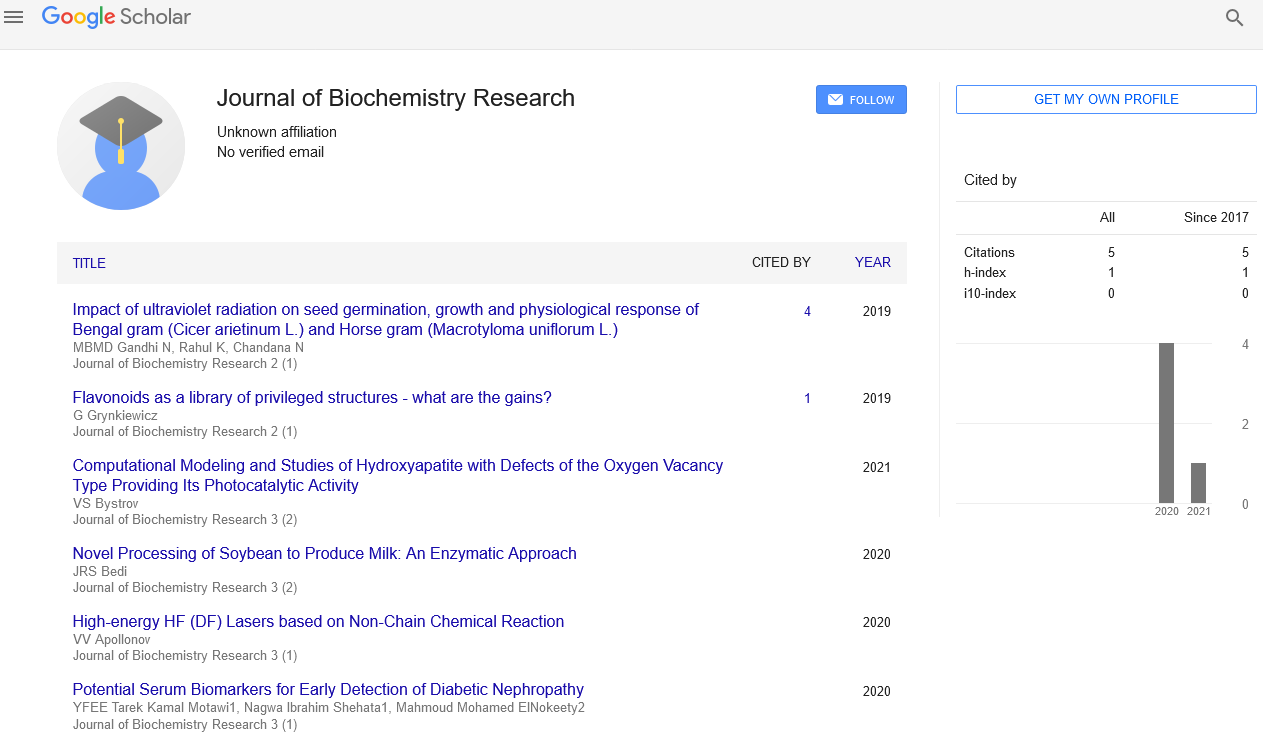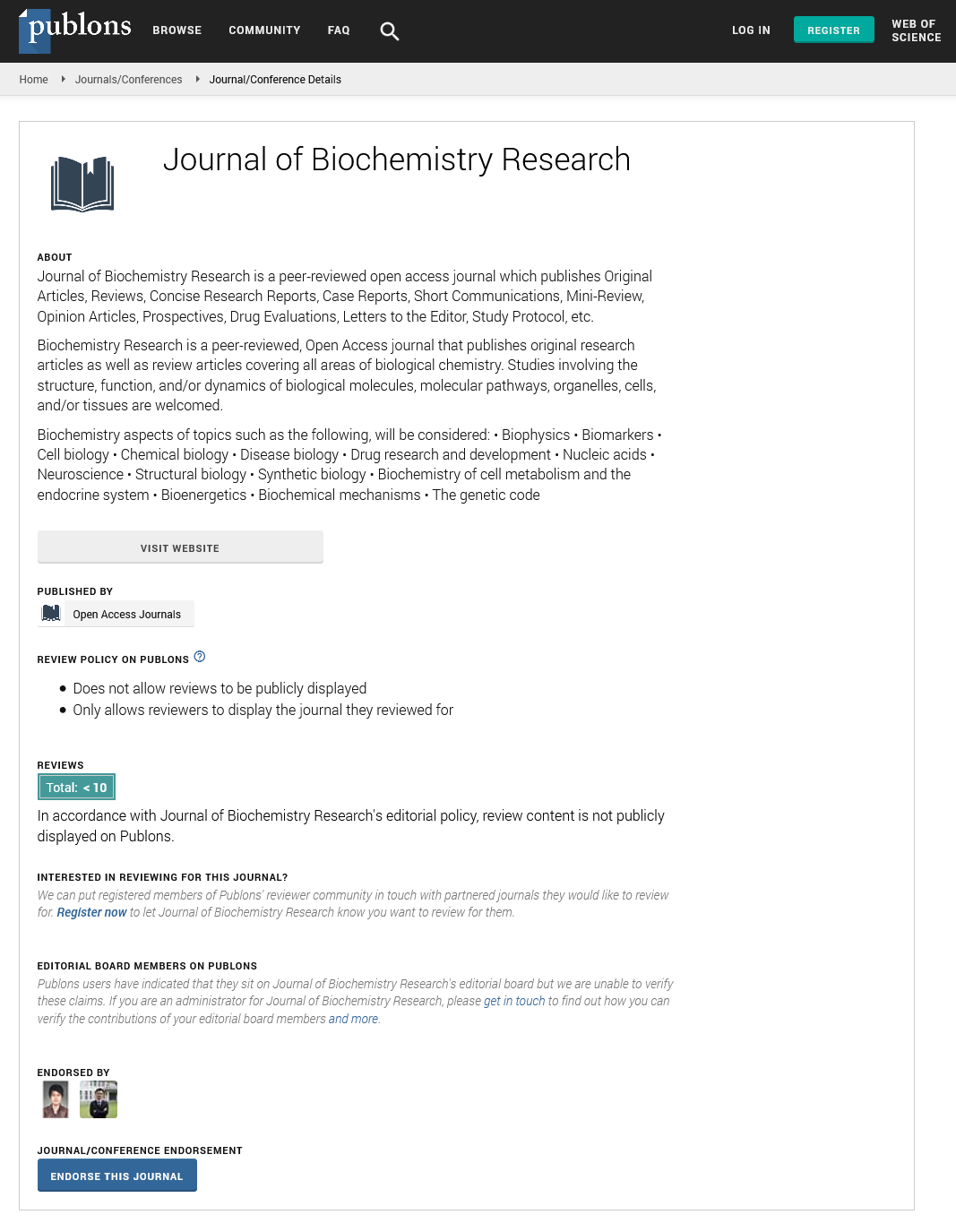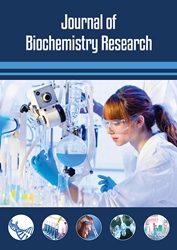Editorial - Journal of Biochemistry Research (2023) Volume 6, Issue 3
The Vast Field of Applied Biochemistry: Enhancing Our World through Molecular Understanding
Kaiyan Chen*
Department of Internal Medicine, School of Nursing, University of Iceland
- *Corresponding Author:
- Kaiyan Chen
Department of Internal Medicine, School of Nursing, University of Iceland
E-mail: kaiyanc@gmail.co.edu
Abstract
Applied biochemistry is a dynamic field that utilizes the principles of molecular understanding to address real-world challenges and improve various aspects of human life. This article explores the diverse applications of applied biochemistry, highlighting its significant contributions in biotechnology, pharmaceuticals, agriculture, environmental remediation, industrial biotechnology, personalized medicine, and synthetic biology. By leveraging a deep understanding of cellular processes and molecular interactions, biochemists have revolutionized these sectors, leading to the development of lifesaving drugs, genetically modified crops, eco-friendly manufacturing processes, and personalized diagnostic and therapeutic approaches. The transformative potential of applied biochemistry is evident in its ability to enhance the quality of life and pave the way for a sustainable future. Applied biochemistry is a dynamic and multidisciplinary field that utilizes molecular understanding to enhance our world across various domains. By exploring the intricate workings of biological systems at the molecular level, biochemists have made remarkable contributions to medicine, agriculture, energy, and environmental sustainability. This abstract provides an overview of the diverse applications of biochemistry and highlights the transformative impact it has had on society. In the realm of medicine, biochemistry has revolutionized healthcare through the development of life-saving drugs, diagnostic tools, and therapeutic approaches. By uncovering the molecular mechanisms behind diseases, biochemists have enabled targeted therapies and personalized medicine, leading to improved patient outcomes and quality of life.
Keywords
Applied biochemistry • Molecular understanding • Biotechnology • Pharmaceutical industry • Agriculture • Environmental remediation • Industrial biotechnology • Personalized medicine • Synthetic biology • Molecular interactions
Introduction
Biochemistry, as a scientific discipline, delves into the intricate molecular processes that govern life. It provides a deep understanding of the chemical reactions and interactions occurring within living organisms, unveiling the fundamental principles that sustain life itself [1]. Applied biochemistry takes this knowledge a step further by applying it to solve real-world problems and improve various aspects of human existence [2]. By harnessing the power of molecular understanding, biochemists have made significant contributions to fields such as biotechnology, pharmaceuticals, agriculture, environmental remediation, industrial biotechnology, personalized medicine, and synthetic biology[3] . The applications of applied biochemistry have revolutionized the way we approach healthcare, agriculture, environmental conservation, and industrial processes [4]. By unraveling the mysteries of biological systems at the molecular level, biochemists have paved the way for groundbreaking discoveries and innovative solutions. From the development of life-saving drugs to the creation of genetically modified crops, biochemistry has transformed industries and positively impacted society [5]. One of the most significant contributions of applied biochemistry lies in the field of biotechnology and pharmaceuticals [6]. Through their deep understanding of cellular processes and molecular interactions, biochemists have identified novel drug targets, designed new molecules, and optimized existing pharmaceuticals [7]. This has led to the development of life-saving medications, therapeutic interventions, and diagnostic tools that have revolutionized healthcare and improved patient outcomes. Moreover, biochemistry plays a crucial role in the production of recombinant proteins, vaccines, and genetically modified organisms, which have far-reaching implications for biotechnology industries [8]. Applied biochemistry has also had a profound impact on agriculture, enhancing crop productivity and food quality. By leveraging their knowledge of molecular interactions, biochemists have developed genetically modified crops with desirable traits, such as disease resistance, enhanced nutrient content, and improved tolerance to environmental stressors. Additionally, biochemistry plays a pivotal role in the development of fertilizers, pesticides, and biocontrol agents that promote sustainable and eco-friendly farming practices, addressing the global challenges of food security and environmental sustainability [9]. In the realm of environmental remediation, applied biochemistry offers innovative solutions for tackling pollution and preserving our ecosystems. Biochemists study microorganisms capable of degrading pollutants and design enzymatic processes for the breakdown of toxic substances [10]. Bioremediation techniques based on biochemistry principles have been successfully employed in the cleanup of oil spills, heavy metal contamination, and wastewater treatment. Furthermore, biochemistry contributes to the development of renewable energy sources, such as biofuels, through the identification and optimization of enzymatic pathways involved in biomass conversion.
Materials and Methods
The field of applied biochemistry encompasses a wide range of research areas and applications, each requiring specific materials and methods tailored to the particular objectives and experiments. While it is not possible to cover all the materials and methods employed in applied biochemistry due to its vast scope, this section will provide a general overview of some commonly used materials and methods in the field.
Laboratory equipment: Applied biochemistry heavily relies on various laboratory equipment for conducting experiments and analyses. This includes basic equipment such as pipettes, centrifuges, balances, pH meters, and microscopes, as well as specialized instruments like spectrophotometers, chromatography systems, DNA sequencers, and mass spectrometers. These instruments are essential for sample preparation, molecular analysis, protein purification, and other experimental procedures. Reagents and chemicals: A wide array of reagents and chemicals are employed in applied biochemistry research. These include buffers, enzymes, substrates, antibodies, nucleotides, primers, dyes, and various organic and inorganic chemicals. These reagents and chemicals are used for various purposes such as DNA amplification, protein expression, enzymatic reactions, and molecular labeling.
Cell culture: Cell culture is a fundamental technique in applied biochemistry, particularly in biotechnology and pharmaceutical research. Different types of cells, including mammalian, bacterial, fungal, and insect cells, are cultured in specialized media containing nutrients, growth factors, and supplements. Cell culture techniques involve maintaining cell lines, optimizing growth conditions, transfecting cells with genetic material, and studying cellular responses to different stimuli.
Protein expression and purification: Protein expression and purification play a crucial role in applied biochemistry, especially in the pharmaceutical and industrial biotechnology sectors. Recombinant DNA technology is employed to introduce genes encoding specific proteins into host organisms such as bacteria, yeast, or mammalian cells. The expressed proteins are then purified using various techniques, including chromatography, electrophoresis, and affinity-based methods, to obtain highly pure and active proteins for further analysis or application.
Molecular biology techniques: Molecular biology techniques are extensively used in applied biochemistry for DNA analysis, gene manipulation, and recombinant DNA technology. These techniques include polymerase chain reaction (PCR), gel electrophoresis, DNA sequencing, gene cloning, site-directed mutagenesis, and DNA hybridization. These methods allow researchers to study genetic variations, gene expression, and protein-DNA interactions, providing valuable insights into biological mechanisms and developing new molecular tools.
Enzyme assays and kinetics: Applied biochemistry often involves studying enzyme activities and their kinetics to understand their roles in metabolic pathways and develop enzymatic processes for various applications. Enzyme assays measure the rate of enzyme catalyzed reactions using specific substrates and detection methods. Kinetic analysis provides information about enzyme-substrate interactions, enzyme efficiency, and inhibition kinetics, contributing to the optimization of enzymatic reactions and the development of enzyme-based products.
Data analysis and bioinformatics: With the advancement of technology, data analysis and bioinformatics have become integral parts of applied biochemistry. Statistical analysis, data visualization, and bioinformatics tools are employed to process and interpret large datasets generated from genomics, proteomics, and metabolomics experiments. Bioinformatics techniques are also used for sequence analysis, protein structure prediction, and functional annotation, aiding in the understanding of biological systems and identifying potential drug targets.
Conclusion
The field of applied biochemistry holds immense promise for enhancing our world through a deep understanding of molecular processes. Through its interdisciplinary nature and its integration with various scientific disciplines, applied biochemistry has revolutionized numerous industries and paved the way for groundbreaking advancements in medicine, agriculture, energy, and environmental sustainability. The application of biochemistry in medicine has led to the development of life-saving drugs, diagnostic tools, and therapies that have transformed healthcare outcomes. From targeted cancer therapies to personalized medicine approaches, biochemists continue to uncover molecular insights that drive innovation and improve patient care. In agriculture, biochemistry has played a pivotal role in enhancing crop productivity, developing genetically modified organisms, and improving food quality and safety. By understanding the intricate mechanisms behind plant growth, nutrient uptake, and disease resistance, biochemists have contributed to sustainable agriculture practices and the mitigation of global food insecurity.
References
- Qaseem A, Vijan S, Snow V et al. Glycaemic control and type 2 diabetes mellitus: the optimal haemoglobin A1C targets, a guidance statement from the American College of Physicians. Annals of Internal Medicine. 147, 417-422 (2007).
- Schwartz SE, Levine RA, Weinstock RS et al. Sustained pectin ingestion: effect on gastric emptying and glucose tolerance in non-insulin-dependent diabetic patients. Am J Clin Nutr. 48, 1413-7 (1988).
- Madorran E, Stožer A, Bevc S et al. In vitro toxicity model: Upgrades to bridge the gap between preclinical and clinical research. Bosn J Basic Med Sci. 20, 157-68 (2020).
- Wang Y. Extracting knowledge from failed development programmes. Pharmaceut Med. 26, 91-96 (2012).
- Griffiths G. Cell evolution and the problem of membrane topology.Cell Biology. 8, 1018-1024 (2007).
- Schopf JW. Fossil evidence of Archaean life. Series B Biological Sciences. 361, 869-885 (2006).
- Fonseca, Frederico Torres. Using ontologies for geographic information integration. Transactions in GIS.6,231-257 (2009).
- Südfeld S.Post-induction hypotension and early intraoperative hypotension associated with general anaesthesia. Br J Anaesth. 81, 525-530 (2017).
- Dora, Veronica Della. Infrasecular geographies: Making, unmaking and remaking sacred space. Prog Hum Geogr. 42, 44-71 (2018).
- Fogel DB. Factors associated with clinical trials that fail and opportunities for improving the likelihood of success: A review. Contemp Clin Trials Commun.11, 156-164 (2018).
Indexed at, Google Scholar, Crossref
Indexed at, Google Scholar, Crossref
Indexed at, Google Scholar, Crossref
Indexed at, Google Scholar, Crossref
Indexed at, Google Scholar, Crossref
Indexed at, Google Scholar, Crossref
Indexed at, Google Scholar, Crossref
Indexed at, Google Scholar, Crossref
Indexed at, Google Scholar, Crossref


